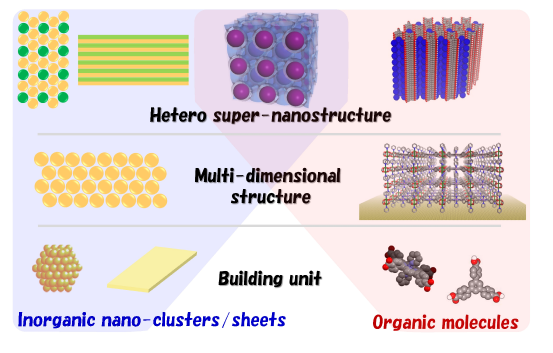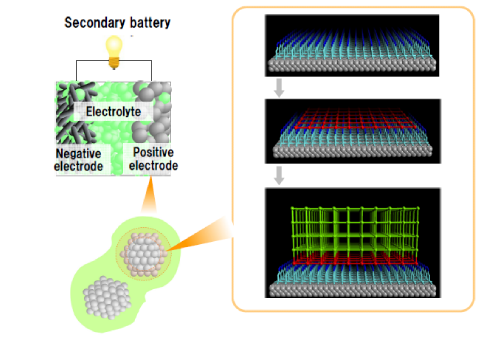Research
Bottom-up assemblies towards the creation of functional hetero super-nanostructures
Our interest lies with the anomalous properties exhibited by nanoscaled materials.
Simple scaling down of easily available materials to the nanometer size often results in the emergence of unique characteristics which are not seen in macro-scale bulk materials. When we take one or more such nano-scaled components and align them with high regularity, i.e. creating hetero super-nanostructures, additional functionalities can be triggered.
For this aim, we first prepare building components of organic molecules or inorganic nano-objects such as nanoparticles/nanosheets. Then we construct multi-dimensional structures by assembling the components like building blocks.。
Especially we focus on developing new energy creation/storage devices such as organic solar cells, thermoelectric devices and secondary batteries.

(1) Development of molecular p-n junctions designed for photo-electric conversion
Photo-electric energy conversion using molecular materials has become feasible through the development of organic bulk heterojunction structures, where charge separation induced by light is realized by a large interfacial area between donor and acceptor.
Although it is known that the blending conditions and molecular packing in each material strongly affect the device performance, the detailed relationship between molecular nanostructures and the optical/electronic properties still remains to be understood.
Our aim is to achieve the construction of molecular level aligned p-n heterojunctions – firstly p-type conducting nano-columns will be created together with well-defined pores, followed by the introduction of n-type molecules into the porous channels.

(2)Interfacial control of secondary battery materials by applying molecular based compounds
Coexistence of an electronically active framework and porosity is attractive from the point of view that introduced guest molecules can switch the framework electronic properties.
There have been reports on magnetic and optical properties of bulk porous materials changed by adsorbed gas molecules. However, only a few combine porosity and electrical conduction at the same time, even though this can open up a range of applications for porous materials such as their use as electrodes of secondary batteries and fuel cells.
Our strategy for creating such nanofilms is to grow conducting chains/columns vertically to the substrate surface while retaining a well-defined separation between the columns. We aim to establish the assembly of such nanofilms not only on flat surfaces, but also on spherical inorganic particles. This will lead to the creation of an ideal interface between the electrode active particles and the electrolyte in secondary batteries through the uniform coating by the electrically/ionically conductive nanostructures as the interfacial condition plays an important role for battery performance and stability.
